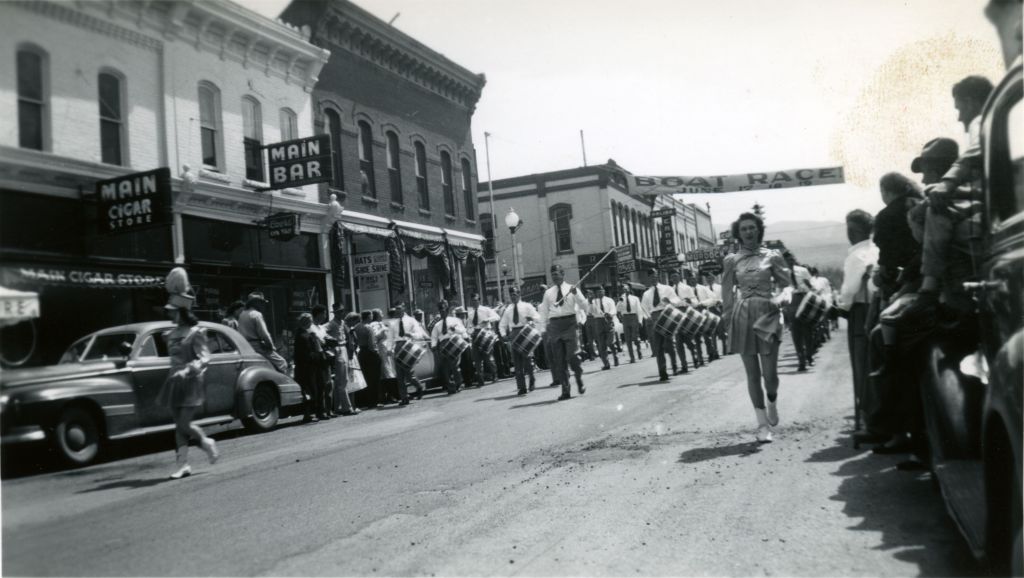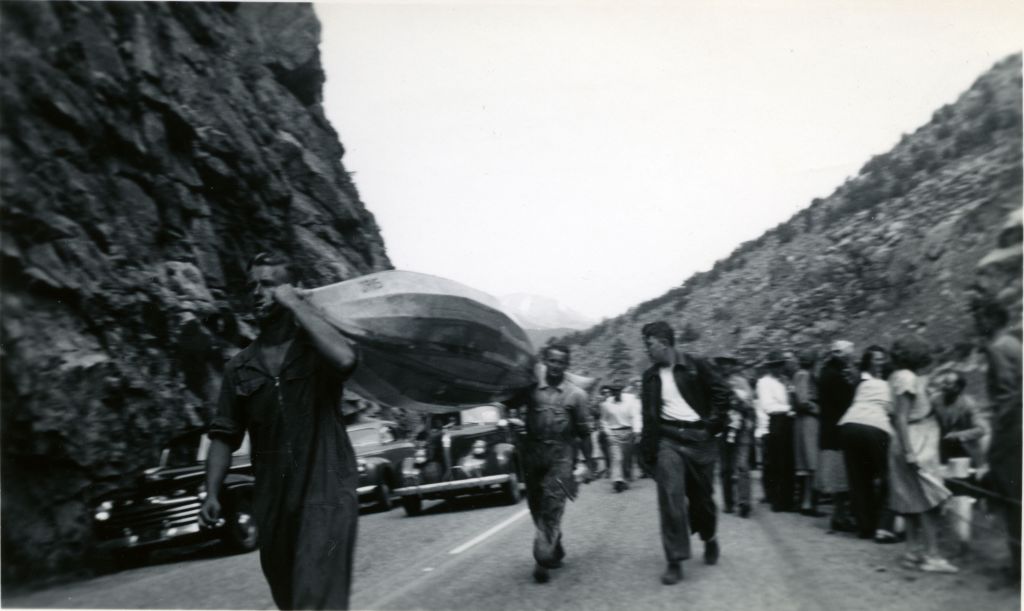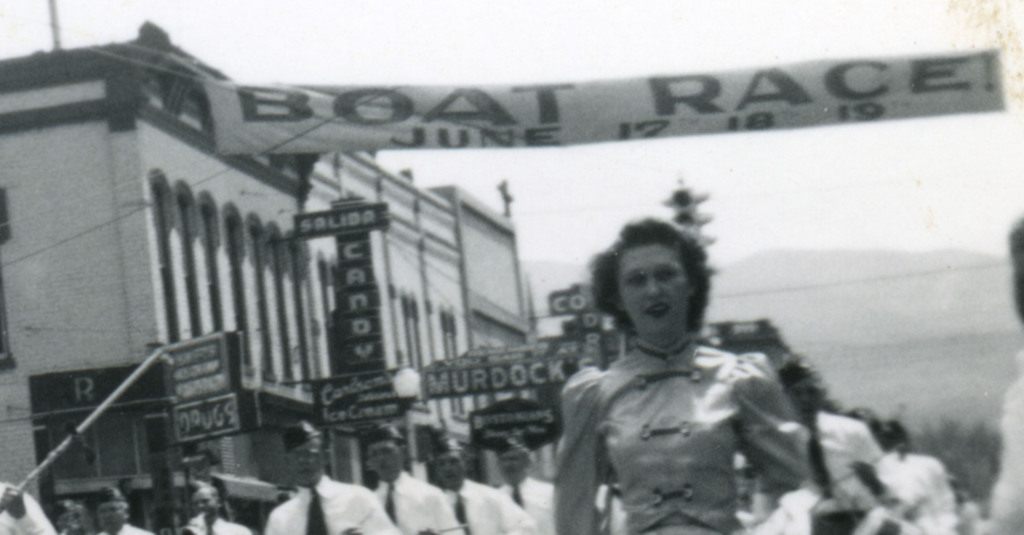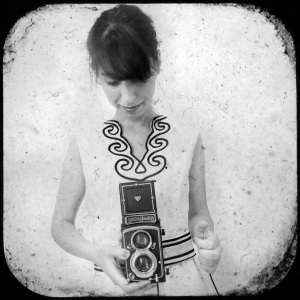Story
Reading Photographs and Discovering Early Photos of Salida’s FIBark Race
We recently made an exciting discovery in our collection: we found photographs of Salida’s first annual boat race, now known as FIBArk (First in Boating the Arkansas). We’re going to show you how we made this discovery by “reading” the photograph and how you can improve your visual literacy skills, too.

Photo from the Bobbie Duncan photographs collection, 91.281.9, Ph.00130, History Colorado, Denver, Colo.
We knew absolutely nothing about this photo at the start of our research, but by reading the photo, or looking at the photo’s visual cues, we were able to uncover a wealth of information. Whenever working with photos in the collection, one of our goals is to answer the who, what, when, where, and why of the photograph.
Here are some of the steps:
Step 1. First and foremost, look at the photo as a 3-D object, not a 2-D one. The photo has a front, a back, and sides. You can gather a lot of information from the object itself, not just what is depicted in the image. Examine all surfaces of the photo and see if it has any captions, dates, and/or photographer’s information written, stamped, or printed on it. If we had a photographer’s stamped logo, for example, we could look in city directories and determine the years that studio was in operation. Beware that information written on photos is not always accurate! This photo, unfortunately, had no additional information. Let’s go to step 2.
Step 2. Determine what type of photo process and format it is. The photo process refers to the technical and chemical methods for generating an image, while the photo format is the special form the image takes for a specific purpose, such as mounted to a cabinet card or stereograph. So, for example, you could have an albumen print process on a cabinet card format. Our photo is an unmounted gelatin silver print, and we know that this process was used from the mid-1880s on. This is a good starting point, but we can do better than that. On to step 3…
Step 3. Can you determine whether the photo was shot by a professional photographer or an amateur? This might help us answer our why question, or the purpose of the photo. Is it a studio portrait? a formal group portrait? a candid shot? In this case, the image appears to be a snapshot and was probably photographed by a tourist. The photo is from the Bobbi Duncan collection, which depicts Duncan and her family and friends traveling around Colorado. It’s very likely the image was shot by Bobbi Duncan herself, or someone close to her, while she was visiting Colorado.
Step 4. Now it’s time to look at what’s depicted in the photograph and read the visual clues to interpret what’s going on in the scene. Be sure to pay specific attention to clothing, hairstyles, cars, license plates, street signs and technology (power lines, street lamps, etc.) that may provide clues to the where and when. In this example, we have some sort of event, probably a parade. The clothing and cars help date the photo to the late 1940s or early 1950s.
When we enlarge the photo we can see a street sign that says “Salida” and a banner that reads “Boat Race June 17 18 19.” Great! Now we know where: Salida, Colorado. And the banner helps us narrow down the what: a boat race and when: June 17, 18, or 19 in the late 1940s or early 1950s.
Step 5. Now look at the photo in context, or in relation to other photos in its collection. What other clues can you gather from the collection as a whole? Other photos in this collection also depict crowds and boats. These confirm that they must have been shot at a boat race in Salida.
Step 6: Take the information you’ve gathered so far and do additional research to help narrow down the subject matter further. By using primary and secondary sources such as historical newspapers and books, as well as Internet searches, we were able to determine that every year since 1949, Salida has held an annual boat race and festival in June. Contestants race down the Arkansas River during the spring’s snow runoff. In the early years it was just called “Boat Race” but it was eventually renamed “FIBArk.” Historic Salida newspapers helped us determine that the only year the boat race was held on June 17, 18, and 19 in the years 1949-54 was in 1949. Excellent! We have our date: June 1949!

Photo of Max Romer, Robert Ris, and Paul Pasquale at the first annual Salida Boat Race in 1949. Bobbie Duncan photographs collection, 91.281.17, Ph.00130, History Colorado, Denver, Colo.
Then we made another exciting discovery. We found a photo in the Salida Daily Mail depicting and identifying the 1949 Boat Race contestants. Three of the men in the photo matched a photo in our collection! It turns out this photo depicts the two winners of the first Salida Boat Race! At left is Max Romer and right is Robert Ris, both of Switzerland. The man walking next to Ris was a fellow contestant, Salida’s own Paul Pasquale. So not only do we have photos of the very first FIBArk race, we have photos of the very first winners! Isn’t visual literacy fun?
By looking at photos as objects and by reading their visual cues both in the scene AND on the photo, you can discover a whole hidden world. Want to give it a try? Head over to our Collections Online, click on the second tab and select the Photographs category. Also, join us on Dec. 2 for our History Sleuths: Identifying Family Photographs program. In this three-hour hands-on workshop, you’ll learn how to identify people, events, places, and dates of photographs! Check out our website for more details.
Happy reading!
Happy American Archives Month! This month we’ve been sharing some behind-the-scenes stories about the work we do in History Colorado’s photograph archives. Check out our last blog post about daguerreotypes here!


